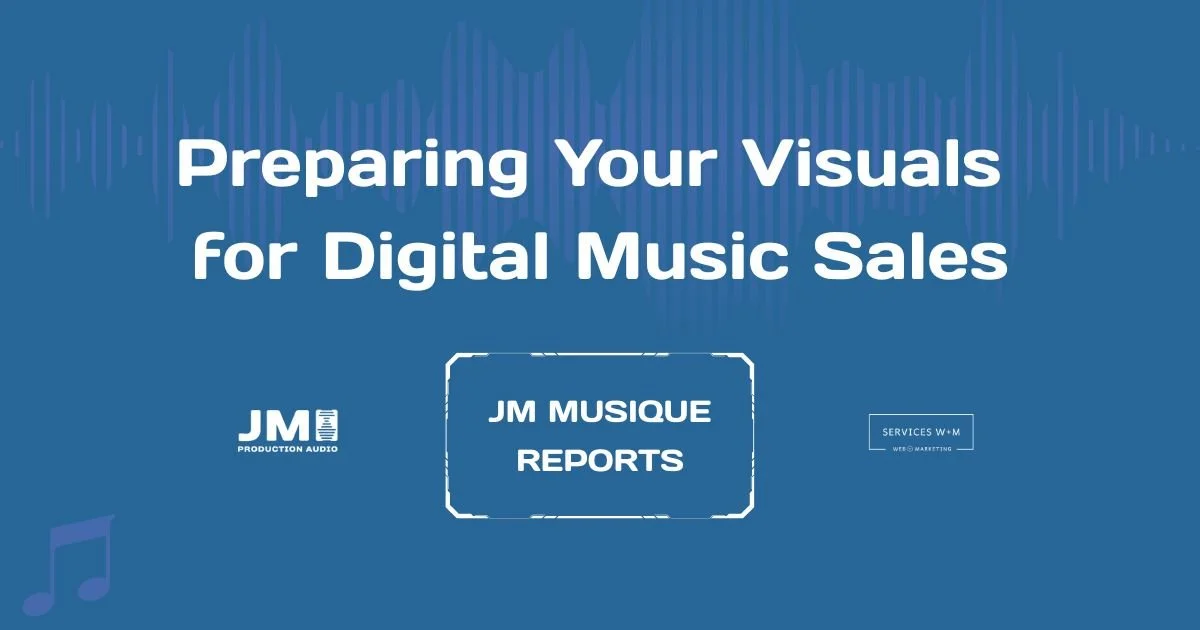Preparing Your Visuals for Digital Music Sales
Tips on crafting visuals for digital music sales: 3000x3000 px cover art, social media formats, and a consistent graphic identity.
Exclusive JM Musique Report.
Hello,
Publishing a song online is not just about uploading an audio file. On streaming and digital sales platforms, visuals are just as important as sound. An eye-catching cover, well-adapted social media versions, and a consistent identity can make the difference between a track that goes unnoticed and a release that grabs attention.
At JM Musique, every composition is supported by visual work developed in partnership with Services W+M, which provides advertising design and digital promotion services. This report takes a closer look at best practices for preparing your visuals.
The Cover: Catch the Eye Before the Ear
The cover is the very first impression of your music. It’s what listeners see before they even hear the first note. A good cover must be clear, readable, and reflect the mood of the track. More than just an image, it becomes the storefront of your artistic universe.
To understand the impact of a strong visual, just think of album covers that have made history. They’ve become cultural icons in their own right—sometimes as famous as the songs themselves.
Top 4 Iconic Album Covers
The Dark Side of the Moon – Pink Floyd (1973). The Hipgnosis prism: minimalist, powerful, and symbolic of progressive rock itself.
Abbey Road – The Beatles (1969). Four silhouettes crossing a street: simple yet universal, instantly recognizable even without text.
Nevermind – Nirvana (1991). The baby swimming after a dollar bill: a bold, shocking image that became the symbol of grunge culture.
Thriller – Michael Jackson (1982). Michael in a white suit, leaning back and smiling: a glamorous, confident cover tied to the best-selling album of all time.
These examples remind us that a successful cover goes beyond aesthetics. It tells a story, conveys an identity, and imprints itself in collective memory.
Building a Consistent and Omnipresent Visual Identity
A song may capture the ear, but a strong visual identity locks an artist into the audience’s memory. Repeating the same colors, typography, and graphic styles from one release to another builds a recognizable image at first glance. Adding a logo or visual signature strengthens this consistency and establishes your name in the public’s mind.
The biggest acts understood this long ago:
ABBA, with its mirrored “B,” instantly identifiable.
The Rolling Stones, with their iconic red tongue-and-lips logo.
Metallica and Daft Punk, both of whom consistently extended their visual identity across every release and performance.
For independent artists, the same logic applies: don’t stop at the cover. Bring your visual identity everywhere:
In your music videos (style, colors, animated typography).
In promotional campaigns (posters, ads, Meta Ads).
On social media (stories, banners, avatars, branded hashtags).
Even in press releases (logo placement, branded templates).
Through repetition, this coherence creates familiarity. Your audience recognizes your work before they even listen—building trust and projecting professionalism.
JM Musique Visual Production: The W+M Checklist
1. The Cover: Your Main Showcase
Platforms typically require a square 3000 x 3000 px, high-resolution cover.
Keep it simple and legible, even at thumbnail size.
Make artist name and/or track title clear, with visuals reflecting the music’s mood.
2. Social Media Versions
Prepare horizontal, vertical, and square formats for Instagram, Facebook, TikTok, and YouTube.
Create animated teasers (e.g., 15-second clips with dynamic visuals).
Use vertical 9:16 Stories for immersive mobile impact.
3. Brand Consistency
Repeat colors, fonts, and visual style across all releases.
Always include your logo or visual signature (e.g., JM Musique).
Align your music visuals with your website, magazine, and ads.
4. Support from Services W+M
Cover art design.
Platform banners.
Social media assets.
Advertising-ready visuals for Meta Ads and Google Ads.
This design + music partnership maximizes the visibility of each release while giving independent artists a professional presentation.
Conclusion
Music is as much a visual as it is an auditory experience. In today’s crowded digital market, audiences often associate image with perceived quality. By preparing strong visuals and adapting them for multiple platforms, you boost your chances of being noticed and remembered.
At the digital age, every launch is a meeting between an ear and an eye. By refining your visuals, you transform your songs into full experiences—ready to attract, captivate, and remain unforgettable.
Thank you,
Jeff Maheux
Production and writing: Services W+M.
W+M exclusive music features — That’s Rock!
Visit the JM Musique Instrumental Tracks Gallery on YouTube! Enjoy!















Discover Poor King, a pop-folk song by Jeff Maheux. A JM Music 2025 revival with W+M! Catchy, witty and full of acoustic energy.